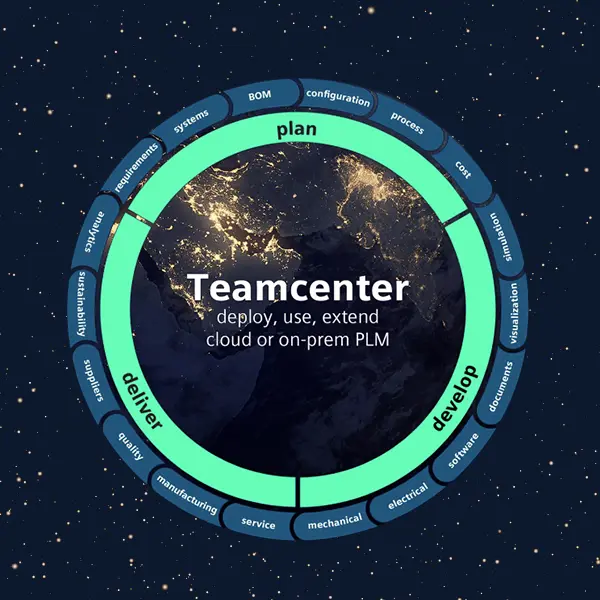Teamcenter PLM Customization
Blog Article | August 13, 2025
What is Teamcenter?
Teamcenter is a PLM software useful in connecting processes and people through an innovative digital thread. The PLM tool leverages the digital twin to preemptively solve problems before they arise, optimizing design workflows, systems, software, visualization, and simulation. Teamcenter PLM automates product lifecycle procedures and streamlines product decisions, boosting visibility and innovation. This enables users to strategically plan and define product designs, document development through the digital twin, and establish an intricate digital thread forming connections between design, manufacturing, and service. An industry-leading PLM solution, Teamcenter is scalable with your business and helps to facilitate its growth. Teamcenter’s support for the digital twin allows companies to create and manage accurate digital representations of physical products. This enables engineers to simulate, analyze, and validate product behavior throughout the development process, thus reducing rework downstream.

Importance of Customization in PLM
Customizing PLM solutions is critical in maximizing efficiency and creativity. Teamcenter’s flexibility and features designed specifically for customization empowers users to significantly boost their productivity, reduce time-to-market, and establish themselves as leaders in their field.
Customization allows companies to:
- Align PLM workflows with real-world engineering and manufacturing operations
- Automate repetitive or manual tasks to boost productivity
- Create user-specific dashboards and interfaces for better adoption
- Integrate with third-party systems like ERP, MES, CRM, or custom databases
- Extend Teamcenter’s functionality to match evolving business strategies
Siemens designed Teamcenter with extensibility in mind. Its service-oriented architecture (SOA), configuration layers, and toolkit support help companies build on a stable core while tailoring the platform for competitive advantage.
Teamcenter PLM Customization Components & Architecture
Customizing Teamcenter requires a deep understanding of its architecture, as the tool is structured into several layers and components. Each serves a different role in the PLM ecosystem.
Teamcenter offers a variety of clients, including the Rich Client (portal), web client (Active Workspace), and CAD-integrated clients. Each has different APIs and customization approaches based on user roles. Teamcenter's service-oriented architecture allows for flexible integration and customization. SOA clients can access Teamcenter services over a standard protocol, making third-party integration and UI element creation possible.
FMS handles storage, replication, and retrieval of files in Teamcenter. Customizations here can address performance, file versioning, or specific vaulting logic.
Understanding these layers helps teams scope projects appropriately and choose the right entry points for customization.
Teamcenter PLM Customization Areas
Customizing Teamcenter can be approached through different modules and techniques, depending on the goal:
- Server Customization – Modify core business logic, implement custom rules, or create event handlers.
- Portal Customization – Adjust the rich client interface using Java-based extensions and user preferences.
- Web or Thin Client Customization – Adapt Active Workspace using declarative style sheets (JSON), JavaScript, and REST APIs.
- SOA-based Customization – Leverage the SOA framework to create services, connect systems, or build web apps.
- BMIDE Extension Customization – Use the Business Modeler IDE to define and configure data models, properties, and relationships.
When these techniques are combined, they enable users to create an adaptive PLM environment.
Customization Details
Server customization is typically done using ITK or Java. It allows developers to:
• Implement custom business logic
• Extend existing Teamcenter operations (e.g., save, revise, release)
• Automate workflows or validation checks
• Create background services or batch processes
This is especially useful for organizations with strict data governance, custom product structures, or automated BOM updates.
The Rich Client (also known as Portal) supports detailed UI and functional enhancements, including:
• Custom menu items and toolbar buttons
• Form and view modifications
• Integration with desktop tools or legacy systems
Portal customization ensures power users and engineers can work efficiently in a familiar environment tailored to their workflow.
Active Workspace is the modern, web-based interface for Teamcenter. Customizing AWC allows teams to:
• Adjust navigation, search filters, and data panels
• Integrate contextual help or training widgets
• Build custom tiles and dashboards for user roles
Customizing AWC enhances the user experience and accessibility, especially for non-technical stakeholders like program managers or executives.
Teamcenter’s SOA layer allows developers to:
• Create services that interact with Teamcenter without using a UI
• Connect PLM data with ERP, CRM, or custom applications
• Build modern web or mobile interfaces on top of Teamcenter services
SOA is the backbone for scalable, flexible PLM deployments, particularly in enterprise environments with many system integrations.
The Business Modeler IDE (BMIDE) is Teamcenter’s tool for defining business object models and metadata. It enables teams to:
- Define custom item types, properties, and relationships
- Control behavior through rule sets and descriptors
- Package and deploy data model changes across environments
BMIDE ensures the digital thread reflects the reality of your business, from design to service.
Best Practices for Teamcenter PLM Customization
Start with business goals rather than technical possibilities. Define clear objectives, scope the level of customization required, and map out dependencies. Use a phased approach:
Phase 1: Standard implementation with minimal configuration
Phase 2: High-impact customizations with measurable ROI
Phase 3: Integrations and UI personalization
Use test environments to validate every customization before deployment. Build test cases for:
• Regression
• Performance
• Compatibility with new Teamcenter versions
Automated testing can reduce the burden and increase confidence in updates.
Custom code must evolve with Teamcenter’s upgrade cycles. To simplify maintenance:
- Follow Siemens’ development guidelines
- Avoid modifying core files
- Use extension points instead of overriding base functionality
Saratech offers ongoing support and upgrade services to help teams sustain their investment.
Common Challenges & Solutions
Why Choose Saratech for Your Teamcenter Customization?
At Saratech, we understand that your PLM system should work for you—not the other way around. Our team of engineers and consultants specializes in custom architecture design, implementation and integration, custom development and scripting, testing and validation, and ongoing support and upgrade management. Whether you are a startup optimizing for growth or an enterprise scaling globally, Saratech’s proven customization strategies ensure your PLM platform accelerates processes and business outcomes.
Final Thoughts
Customization isn’t just about tweaking software; it’s about aligning technology with your people, processes, and products. With Teamcenter PLM and the right partner, you can create a powerful digital foundation that integrates with your systems and evolves with your business.
Contact Saratech today to learn how we can help you unlock the full potential of Teamcenter through tailored customization and expert implementation.


